Article and all photos by Joe Mock, BaseballParks.com
All rights reserved
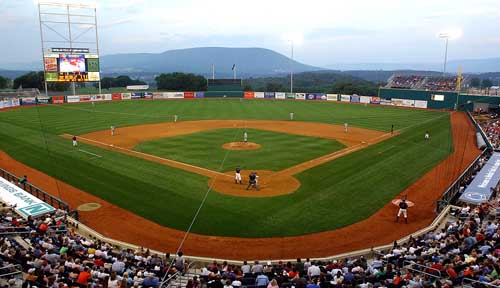 |
If you have to spend time in a hotel, you’d like your room to have a nice view. I’m also sure you wouldn’t want to be cramped, so you’d probably like a roomy room with a view.
| Ballpark Stats |
 |
| Team: State College Spikes of the New York-Penn League (also used by Penn State) |
| First game: June 20, 2006, a 5-3 loss to Williamsport |
| Capacity: 5,406 |
| Architects: L. Robert Kimball along with DLR |
| Price: $31.4 million (from the state, the university and private donations) |
| Home dugout: First base side |
| Field points: East |
| Playing surface: grass |
| Betcha didn’t know: The height of the RF wall is 18.55 feet, commemorating the fact that Penn State was founded in 1855. |
Welcome to State College, PA, where their new ballpark provides enormous legroom plus a great view of Mount Nittany beyond center field.
Medlar Field at Lubrano Park is not only the latest addition to Minor League Baseball, it’s also the newest on the college-baseball scene. That’s because this park, which sits on the edge of Penn State’s campus, is shared by the New York-Penn League’s State College Spikes and the Nittany Lion baseball program. As a college facility, it’s not far from being on the same level as the best ballparks in the land (such as Baylor, Nebraska and Stanford), and certainly gives Ohio State’s beautiful Bill Davis Stadium a run for its money as the biggest and best in the Big Ten. As a NY-Penn League facility, it rivals the big, new parks in Staten Island, Brooklyn and Troy, NY (known as Tri-City).
Before we get into the details of the park, let me explain its long-winded name. Anthony Lubrano, a PSU grad who played baseball for the Nittany Lions, made a significant monetary contribution, so the park is named after him. He specifically wanted to honor his old baseball coach, Chuck Medlar, who guided the PSU program for 19 seasons, twice leading his team to the College World Series. While such naming arrangements (a field name in addition to a park name) are not uncommon at college facilities, it is a little unusual for pro parks to have long names such as this. For the sake of brevity, I’ll refer to the facility as Lubrano Park.
Let’s now take a look at the newly opened ballpark, specifically examining its setting, exterior, architectural design and amenities. By the way, the game I attended here was on a miserable, rainy day, so I am indebted to the Spikes for providing a couple of the photos that show the park in a better light.
The Setting
Lubrano Park is situated on the northeastern edge of the Penn State’s athletic complex, which includes enormous Beaver Stadium and the school’s basketball arena, the Bryce Jordan Center.
If you happen to view a Spikes game from the bleachers in right field or the picnic area down the left-field foul line (like in the shot below), the presence of the football stadium is inescapable, as it towers over the ballpark behind its home plate — in much the same way that Orlando’s mammoth Citrus Bowl dwarfed the Tinker Field baseball park.
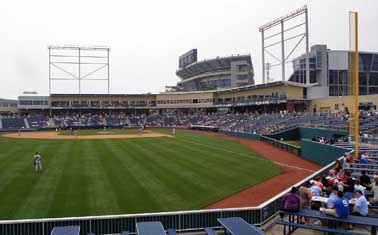 |
But even with all of its height, most Nittany Lion football fans can’t see their beloved Mount Nittany while they’re attending a game at Beaver Stadium. That is rectified at the new ballpark, as the outfield is kept fairly open so that the mountain can be seen very clearly from the seats (see the photo at the top of this page). In fact, the park opens to the east to maximize this view.
For those driving to see the Spikes or PSU play baseball, Lubrano is quite near the intersection of U.S. Highways 220 and 322 on the northern edge of State College.
The Exterior
And speaking of the university’s sports complex, aspects of the exterior of Lubrano Park are meant to complement the look of the nearby football and basketball facilities. Specifically, the brick used is reminiscent of the Jordan Center across the parking lots from the ballpark.
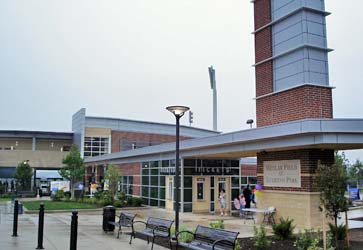 |
The “footprint” of Lubrano Park is unusual, in that the moderately round facility has what looks like an arm extending outward toward the street (see above). The “arm” contains the souvenir shop and the ticket windows. This design is both functional and attractive. I think this approach is not used more often because most ballparks don’t have the space to employ it. Watch for this design to be duplicated in other minor league stadiums in the future.
Closer to where this “arm” meets the main structure are the main entry gates. The left-hand shot below shows this from the outside looking in. The location of the gates creates a plaza of sorts, which is a welcome approach, since it’s a great rendezvous point (see right-hand shot, with the huge football stadium dominating the background).
 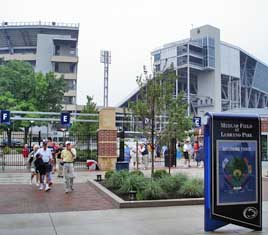 |
One other noteworthy aspect of the exterior of the park is the landscaping. This is sometimes a neglected aspect of a new park, especially in its first year. Not so at Lubrano, where it’s obvious a lot of effort went into the placement of attractive trees and bushes.
The Design
DLR, the architectural firm behind the other new ballpark in the affiliated Minors this year (Greenville, SC), collaborated with L. Robert Kimball in designing Lubrano Park.
The overall layout is similar to what we’ve seen at other Minor League parks in recent years: an upper level with luxury suites and the press box, with the main seating bowl being below street level, meaning you walk down to your seats from the main concourse. That concourse, though, is much wider than at other parks, giving fans ample room to move around. Further, between the entry plaza and the concourse is an opening (where you walk underneath the upper level) that is very, very wide. This is a welcomed feature, especially on a rainy day. In fact, Chuck Greenberg, the Spikes’ president, pointed out to me that the park has sufficient covered space that all the fans in a capacity crowd would be able to take cover in the event of a storm.
 |
Another design element that jumps out at you from the moment you enter the park is how spacious the seating bowl is. The space between the rows is 42″, which means more legroom than you’ve probably ever encountered at a ballpark. This also permits others in your row to pass in front of you without necessitating that you stand up to let them by. Excellent idea!
An unusual design element involves the visitors’ bullpen, down the third-base line. It is virtually embedded in the stands. You can see it on the right side of the photo in the “Setting” section above. It isn’t quite surrounded by seats like the ones in the Texas League park in Frisco, TX, but it is an unusual sight.
In the left-field corner is a group-picnic area, where tables hug the wall where it curves around the foul pole. These tables have a very nice view of the action (also visible in the photo in the Setting section). In right field are bleachers which are more elevated than the left-field picnic tables, and their vantage point might even be a little better. The reason these seats are higher above the field is because of the height of the right-field wall: 18.55 feet. Why this strange number you ask? It’s to commemorate the fact that Penn State was founded in the year 1855, of course!
I need to mention one other element of the design — one which most fans attending a Spikes or Nittany Lions game probably won’t get to see. The upper level not only features a high-tech, 2,500-square-foot press box for the media types, it also provides room for academic activities. There are luxury suites that can be utilized as classrooms, and a special observation room was included where journalism students (ah, yes, I remember being one of those a couple of decades ago!) can peer through a wide window into the press box to watch the media at work. “Our goal was for this to function as a pro park, a college park and an academic setting,” Greenberg told me.
The Essentials
The General Manager of the Round Rock Express has told me on a couple of occasions that I definitely “over married.” For those of you who aren’t familiar with this expression, it conveys that I am beneath my wife in several respects, not the least of which is looks.
Well, in most respects, it will dawn on many fans that State College “over built” in creating Lubrano Park. It is certainly larger than almost any college ballpark outside of the baseball-crazy campuses in the South and Southwest, and its seating capacity and fan amenities put it ahead of almost all parks at its level of the Minors (i.e., short-season A). It’s a combination that works well for both Penn State and the Spikes, especially since their schedules don’t overlap at all.
And I bet that fans of the Nittany Lions and the Spikes aren’t going to complain any, either! This ballpark isn’t only roomy and comfortable, it’s also aesthetically pleasing on several levels — and the food is fantastic!
Let’s go through the list of features and amenities one by one. As you would imagine with a ballpark across the street from a truly massive football stadium, there is no lack of parking. However, unlike at some parks at this level, it’s not free. The cost to park your car is $3.
The ticket prices, which top out at $11 for “Diamond Club” box seats (which is what I purchased for the game I attended), strike me as high for this level. In fact, box seats for Spikes games cost the same as at many Triple-A venues — and in fact, exceed several. Field boxes, which are just beyond the dugouts, cost $9, while bullpen boxes are $7 and the right-field bleachers are $6.
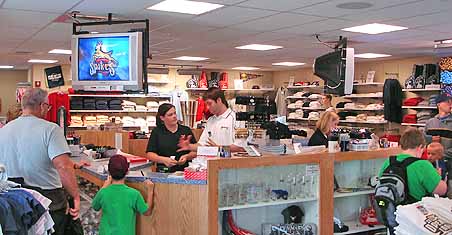 |
Programs are free, though, while the cost of souvenirs and food struck me as quite reasonable. The team store, which is beautiful (and is probably nicer than at any park in the NY-Penn League, with the exception of Brooklyn), features adult T-shirts at $18, and lapel pins — my favorite souvenir — at $5. It’s the food, though, that really blew me away. A very-good “walking taco” (meaning, one assumes, that it’s easy to carry around while eating it) was only $3.50. Regular hot dogs are only $2.75. For those who want something more on the light side, Chicken Caesar Wraps are $5.50. The Right Field Grill serves some higher-end items, like a half-pound Angus burger for $5.50, a rib-eye sandwich for $6.50 and a barbecued half chicken for $5.50.
For those with a sweet tooth, funnel cakes — with various toppings — abound. This is certainly a Pennsylvania treat, so make sure to try one. With two toppings, they are $4.00. And at $2.25, there’s even a fried twinkie!
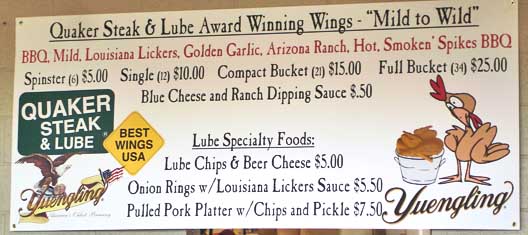 |
But my very favorite food stand carries an interesting name: Quaker Steak & Lube. The story I was told was that the original location for this establishment was a former “quick lube” facility owned by Quaker State. The owners decided — cleverly, I might add — to call their eatery by a very similar name … and even the logo is eerily similar to Quaker State’s.
But none of this would’ve mattered if the food were only so-so. To the contrary, its quality is phenomenal, including some of the very best chicken wings I’ve ever had. Their home-made chips are excellent also. By the way, during my visit to Pennsylvania to review the State College park, I also encountered Quaker Steak & Lube at the ballparks in Altoona and Pittsburgh.
So after you’ve purchased your souvenirs and picked up a bucket of wings from Quaker Steak, you’ll settle into your seat (pleased with the enormous leg room) to watch the game. You’ll appreciate the excellent scoreboard in left-field with its large, high-res video screen. Make sure you bring a radio to the game so you can listen to the Spikes’ play-by-play broadcast, featuring “the voice of Penn State Sports,” the very entertaining Steve Jones.
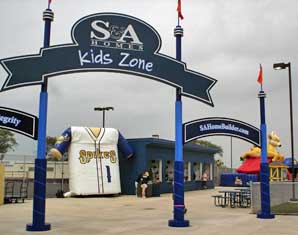 |
For the kids, there is a play area down the third-base line. The S&A Homes Kids Zone features large inflatables, custom-made with the Spikes logo, and a series of carnival-style game booths. Nicely done!
Summary
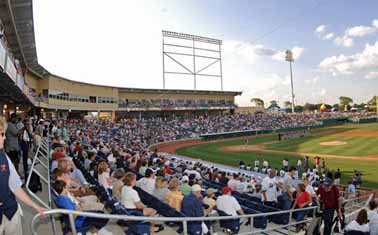 |
So like a fine hotel room, Medlar Field at Lubrano Park offers a great view and is roomy (note the legroom in the photo above). The word “intimate” probably doesn’t come to mind when you look at the ballpark, but I don’t think any of the Spikes’ fans are complaining. Most importantly, not only does this lovely new park put State College on the Minor League map in a very big way, it zooms Penn State up the list of nicest college ballparks in the nation.
 |
A lot of credit for this park goes to Chuck Greenberg and his management team. Even as they were taking over the reigns of the Altoona Curve of the Eastern League in 2002, they were meeting with officials at Penn State about partnering on a venture to upgrade the university’s baseball facility while also bringing in a Minor League team to play in it. It took a lot of effort, financial negotiations and planning, but Lubrano Park went from being an abstract concept to a beautiful reality. The New Jersey Cardinals were purchased by Greenberg’s group in 2005, and relocated to Pennsylvania for the 2006 season. And with Penn State’s baseball team starting to use Lubrano Park in 2007, their standing as a solid program will rise — and it will give them a leg up in recruiting.
Also give credit to Mr. Anthony P. Lubrano for making a significant contribution to this park, and for asking that the playing field be named for his old baseball coach at PSU, Chuck Medlar.
By the way, while in Pennsylvania to see the Spikes, why not do what I did? You can also take in games in Williamsport, a 62-mile drive to the northeast of State College, and Altoona, only 40 miles to the southwest. Williamsport not only features the wonderful Little League Museum, but also the beautiful and historic Bowman Field, home of the Crosscutters of the NY-Penn League. The Altoona Curve, meanwhile, play in Blair County Ballpark, arguably the prettiest park at the Double-A level. The team is operated by the same excellent management staff as the Spikes, by the way. And another plus is that there’s a Quaker Steak & Lube in their ballpark!
Many thanks go to Billy Harner, the Spikes’ Media Relations Manager, for his help in preparing this review and for providing the pictures of the stadium at the top and bottom of this page. Also, I want to thank Chuck Greenberg for his time, and for having the vision to bring a facility like Medlar Field at Lubrano Park to State College!